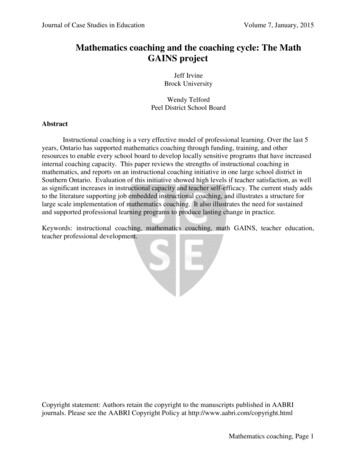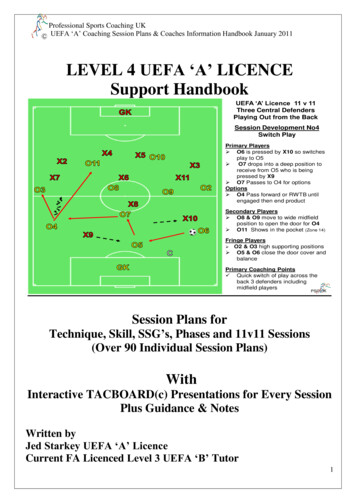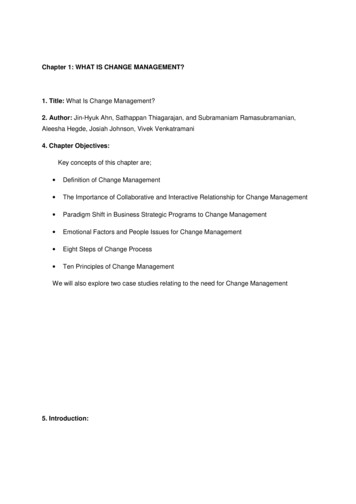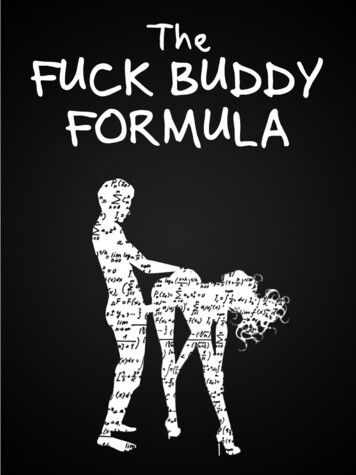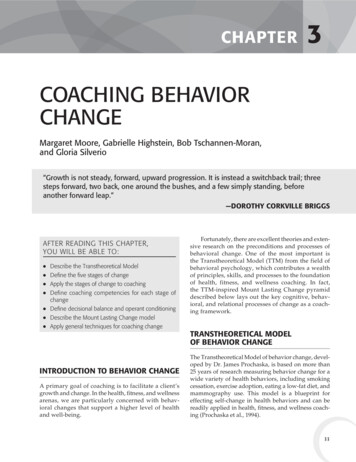
Transcription
CHAPTER3COACHING BEHAVIORCHANGEMargaret Moore, Gabrielle Highstein, Bob Tschannen-Moran,and Gloria Silverio“Growth is not steady, forward, upward progression. It is instead a switchback trail; threesteps forward, two back, one around the bushes, and a few simply standing, beforeanother forward leap.”—DOROTHY CORKVILLE BRIGGSAFTER READING THIS CHAPTER,YOU WILL BE ABLE TO: Describe the Transtheoretical ModelDefine the five stages of changeApply the stages of change to coachingDefine coaching competencies for each stage ofchangeDefine decisional balance and operant conditioningDescribe the Mount Lasting Change modelApply general techniques for coaching changeFortunately, there are excellent theories and extensive research on the preconditions and processes ofbehavioral change. One of the most important isthe Transtheoretical Model (TTM) from the field ofbehavioral psychology, which contributes a wealthof principles, skills, and processes to the foundationof health, fitness, and wellness coaching. In fact,the TTM-inspired Mount Lasting Change pyramiddescribed below lays out the key cognitive, behavioral, and relational processes of change as a coaching framework.TRANSTHEORETICAL MODELOF BEHAVIOR CHANGEINTRODUCTION TO BEHAVIOR CHANGEA primary goal of coaching is to facilitate a client’sgrowth and change. In the health, fitness, and wellnessarenas, we are particularly concerned with behavioral changes that support a higher level of healthand well-being.The Transtheoretical Model of behavior change, developed by Dr. James Prochaska, is based on more than25 years of research measuring behavior change for awide variety of health behaviors, including smokingcessation, exercise adoption, eating a low-fat diet, andmammography use. This model is a blueprint foreffecting self-change in health behaviors and can bereadily applied in health, fitness, and wellness coaching (Prochaska et al., 1994).33
34PART I Core Coaching SkillsFIVE STAGES OFCHANGE MODELThe five stages of change model, developedby Dr. Prochaska, provide coaches with anunderstanding of how and when behaviorscan be altered and why clients may struggle,fail, or quit.Your clients may have decided to employ a coachbecause they already recognize they need and wantto adopt new fitness, wellness, and health-relatedbehaviors—and they are committed to doing so. Healthand wellness behavior change is particularly challenging, particularly today (see page 4). If it were easy,your clients probably would not be seeking your helpor would have already made and sustained the changesthey need and desire.Research has shown that self-change is a stagedprocess. We move from not thinking about changing a behavior to thinking about it, to planning tochange, and to testing out ways to do it before weactually start.Using inappropriate techniques that prematurelyencourage new behaviors can discourage change.For example, people who have not yet made up theirminds to change are not sufficiently ready to adoptbehavioral strategies. Applying this kind of pressure can cause them to withdraw from the changeprocess.To avoid such an outcome, it is important to identify the stage of change that clients may be in when theyfirst come to coaching for each area in health, fitness,and wellness. This approach relates less to their outlook on life than to their readiness to change a specificbehavior. Clients will typically be in different stagesof change for different areas or behaviors (e.g., eatinghabits, physical activity, stress coping, positive selftalk, or relaxation practices).It is also important to recognize that your client maymove forward toward action or may slip back towardinaction during the time you are working together.When you are aware of the stage your clients are in,you can apply techniques for assisting change that arespecific and effective for the stage they are in. Application of specific techniques at each stage will help youcoach your clients to reach their health, fitness, andwellness goals more quickly and effectively and be ableto maintain them.STAGES OF CHANGE AND EFFECTIVECOACHING SKILLS FOR EACH STAGEThe stages that people move through are very predictable and identifiable—beginning with the precontemplation stage where individuals are not yet thinkingabout making change, all the way through to the maintenance stage where changes have been adopted as away of life. The characteristics people exhibit at eachstage are distinct and recognizable.DON’T FORGET . . .The five stages of change are:1.2.3.4.5.Precontemplation (Not Ready for Change)Contemplation (Thinking about Change)Preparation (Preparing for Action)Action (Taking Action)Maintenance (Maintaining a Good Behavior)IMPORTANT!Most of your client prospects will be in the contemplation and/or preparation stage for at least onearea (fitness, weight, nutrition, stress, mental orphysical health) and your coaching program willhelp them reach the maintenance phase (sustainingthe new behavior consistently week to week) within3–6 months. You may be able to help them moveforward in areas where they are precontemplatorswhen openings emerge in the coaching discussions.Also, when clients progress in one area, their confidence in self-change grows and they may becomeready to move forward in another area.Precontemplation: “I Won’t” or “I Can’t”When someone is not even thinking about adoptinga healthy behavior, it’s usually because they fall intoone of two categories of people: the “I Won’t” or the“I Can’t” people. The “I Won’t” people are not interested in changing because they do not feel they have aproblem. Family and friends may feel otherwise andmay be nagging them about it, but they fail or refuseto see the problem. The “I Can’t” people would like tochange but they don’t believe it’s possible. For verydifferent reasons, both kinds of people are not evencontemplating, let alone working on, making a changewhen it comes to that area of their lives.
CHAPTER 3 Coaching Behavior ChangeCoaching Skills to Use in thePrecontemplation StageTo move forward, precontemplators first need sincereempathy from their coaches. This is the time to usereflections to show that you understand and respecttheir feelings and needs. Your ability to recognize andto accept that they do not intend to change a particularbehavior is the key to future possibilities. You are notasking them to move forward on the change processat this time. Instead you are focused on understanding them at a deep level without judgment or fear(for additional material on empathy using NonviolentCommunication, see Chapter 5).For most “I Won’t” people this is the importantmessage: “I understand that you are not ready rightnow. That is fine. Here is how you can contact me ifyou decide at some point that you are ready.” Youleave clients feeling good about the interaction so theywill think about you in a positive light. You do notmake them feel judged or that they are inadequate.The “I Can’t” people are aware they have a problem and need to change, but they believe change is toocomplicated and/or difficult. They may have tried andfailed in the past. These people are acutely aware oftheir barriers and need help to look at the barriers in apositive and rational way so they can learn from themrather than being overwhelmed by the negative emotions generated by past failures.With a coach, clients can sort their barriers intothose that are real and need to be put to the side rightnow, those that are excuses, and those that can be overcome by a strong enough motivator. Taking real barriers, for which time may have to elapse beforeresolution, off the table can lower the client’s emotional level. The client doesn’t have to convince you,the coach, about the barrier. This acceptance showsyour clients that you are on their side. The client is thenmuch readier to work with you to find a strong, positive motivator. When clients have something theyreally want and they know that this change will give itto them, they are far more motivated to work on finding solutions to barriers that have tripped them up inthe past.Contemplation: “I May”We call the Contemplation Stage the “I May” Stage.At this stage, clients are thinking about changing anunhealthy behavior or adopting a healthy behavior—and are considering taking action within the next6 months. They are more aware of the benefits inherent in changing and less satisfied with their presenthealth and well-being than the precontemplators.35They may express a fair amount of ambivalenceabout change, feeling that change will be difficult oreven impossible to achieve. People can remain in thisstage for a long time and become chronic contemplators because they cannot imagine themselves behavingdifferently and/or they do not know how to change.They are still weighing the benefits of change againstthe effort it will take.When openings emerge with “I May” people, youmay be able to explore their best experiences withchange in the past as well as the positive reasons fordoing a particular behavior in the future. By focusingon their values and vision, they may come to appreciate how change would improve their life. When appropriate, coaches can share important scientific factsabout the benefits of the behavior and can assist clientsto discover the pros that might serve as positive andeven powerful motivators for change.Coaching Skills to Use in the Contemplation Stage Help clients move beyond the contemplationstage by connecting them to their strengths andassisting them to get excited about change. Thediscovery work alone may be enough to movethem to the next stage of change. Increasingtheir awareness of compelling reasons to changeand getting them to connect with people whohave successfully made the change are keymotivational strategies. Assist these clients to connect the dots betweenthe changes they seek and the values they hold.Setting behavioral change in this larger context makes the change more meaningful andsignificant. If clients have not sufficiently identified theirpersonally compelling motivators to change,including new supportive relationships andnew reasons to change, help them to think thisthrough. A clear vision of what they want (notwhat they don’t want) is essential. Help these clients examine not only the upsidebut also the downside of giving up old behaviorsfor new, healthier behaviors. Identify which barriers are real and which can be worked out. Normalize, don’t catastrophize. Help these clients identify and accomplish small,realistic thinking and feeling goals every week,thereby empowering them to be more confidentin their ability to change. A series of small successes builds self-efficacy. Remember that, at this stage, the small goals willinvolve reading, thinking, talking, listening, discovering, and deciding—not doing a behavior.
36PART I Core Coaching SkillsIMPORTANT!To move contemplators into preparation and theninto action, be sure they: Find strong motivators Understand their challenges Identify possible solutionsPreparation: “I Will”This is known as the “I Will” Stage. In the PreparationStage, ambivalent feelings have been largely overcome. Clients have strengthened their motivation andthey are planning to take some action within the nextmonth. These clients have a strong motivator. Theyknow what their barriers are and they have come upwith some possible solutions. If these thinking tasksare not accomplished then they are still in Contemplation. During this stage, clients experiment with theirpossible solutions, discard the ones that do not work,and think up new approaches.cardiovascular exercise, which suggests that exercisebe done 3–5 times a week for 20–60 minutes at a timeat a moderate to high level of intensity. Or, they maybe meeting whatever specific set of dietary criteriatheir physicians have prescribed for them.During this stage, which lasts up to 6 months, clientsare working on building new relationships, practicingnew behaviors, and establishing new habits. They mayhave to concentrate very hard while practicing the newbehaviors and refining their lifestyles. The bulk ofcoaching generally takes place with people who are inthis stage, as well as in the preparation stage.IMPORTANT!Because there is a high risk of lapse and relapseback to preparation at this stage, techniques tomanage challenging situations are important. Notethat there is a distinction between lapse andrelapse. A lapse is a single slip in a desired behaviorthat may or may not lead to a relapse. Whethera lapse becomes a relapse depends on the individual’s response to lapses, their perceived loss ofcontrol, and their social network.Coaching Skills to Use in the Preparation Stage Help your clients move through the preparationphase by assisting them to concretize their plansfor change. Encourage them to write down aformal statement of what they are committingthemselves to do, containing specific details ofwhat, when, and how. Help your clients by brainstorming and identifying lots of small steps they can take that areactionable and realistic. Brainstorming can bedone together, with both the coach and the clientcoming up with ideas. If clients exhibit ambivalence or resistance tochange, help them to explore the difficulties ofdoing the new behaviors and encourage themto identify ways to work these out. Do not addto the resistance by telling clients what to do. Discuss situations clients think could be problematic when they actually start the behavior,and have them develop strategies to cope beforethe situation arises.Action: “I Am”The action stage is known as the “I Am” Stage. In thisstage, clients have identified the new behavior thatthey want to establish and are doing it consistently,building up to the target level. For example, they maybe working toward meeting the ACSM definition ofA coach can help the client explore their challengingsituation and to learn from it. Who were they with?Where were they? What was going on? How were theyfeeling? What can th
of health, fitness, and wellness coaching. In fact, the TTM-inspired Mount Lasting Change pyramid described below lays out the key cognitive, behav-ioral, and relational processes of change as a coach-ing framework. TRANSTHEORETICAL MODEL OF BEHAVIOR CHANGE The Transtheoretical Model of behavior change, devel-oped by Dr. James Prochaska, is based on more than 25 years of research

